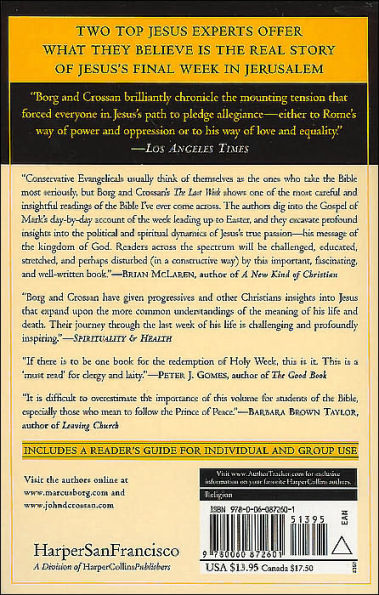Top Jesus scholars Marcus J. Borg and John Dominic Crossan join together to reveal a radical and little-known Jesus. As both authors reacted to and responded to questions about Mel Gibson's blockbuster The Passion of the Christ, they discovered that many Christians are unclear on the details of events during the week leading up to Jesus's crucifixion.
Using the gospel of Mark as their guide, Borg and Crossan present a day-by-day account of Jesus's final week of life. They begin their story on Palm Sunday with two triumphal entries into Jerusalem. The first entry, that of Roman governor Pontius Pilate leading Roman soldiers into the city, symbolized military strength. The second heralded a new kind of moral hero who was praised by the people as he rode in on a humble donkey. The Jesus introduced by Borg and Crossan is this new moral hero, a more dangerous Jesus than the one enshrined in the church's traditional teachings.
The Last Week depicts Jesus giving up his life to protest power without justice and to condemn the rich who lack concern for the poor. In this vein, at the end of the week Jesus marches up Calvary, offering himself as a model for others to do the same when they are confronted by similar issues. Informed, challenged, and inspired, we not only meet the historical Jesus, but meet a new Jesus who engages us and invites us to follow him.
Top Jesus scholars Marcus J. Borg and John Dominic Crossan join together to reveal a radical and little-known Jesus. As both authors reacted to and responded to questions about Mel Gibson's blockbuster The Passion of the Christ, they discovered that many Christians are unclear on the details of events during the week leading up to Jesus's crucifixion.
Using the gospel of Mark as their guide, Borg and Crossan present a day-by-day account of Jesus's final week of life. They begin their story on Palm Sunday with two triumphal entries into Jerusalem. The first entry, that of Roman governor Pontius Pilate leading Roman soldiers into the city, symbolized military strength. The second heralded a new kind of moral hero who was praised by the people as he rode in on a humble donkey. The Jesus introduced by Borg and Crossan is this new moral hero, a more dangerous Jesus than the one enshrined in the church's traditional teachings.
The Last Week depicts Jesus giving up his life to protest power without justice and to condemn the rich who lack concern for the poor. In this vein, at the end of the week Jesus marches up Calvary, offering himself as a model for others to do the same when they are confronted by similar issues. Informed, challenged, and inspired, we not only meet the historical Jesus, but meet a new Jesus who engages us and invites us to follow him.

The Last Week: What the Gospels Really Teach about Jesus's Final Days in Jerusalem
256
The Last Week: What the Gospels Really Teach about Jesus's Final Days in Jerusalem
256Paperback(Reprint)
Related collections and offers

Product Details
| ISBN-13: | 9780060872601 |
|---|---|
| Publisher: | HarperCollins Publishers |
| Publication date: | 01/30/2007 |
| Series: | Plus Series |
| Edition description: | Reprint |
| Pages: | 256 |
| Sales rank: | 51,481 |
| Product dimensions: | 5.30(w) x 7.90(h) x 0.70(d) |
About the Author
What People are Saying About This
Customer Reviews
Explore More Items
Relive the sensuality, the romance, and the drama of Fifty Shades Freed—the love story that enthralled millions of readers around the world—through the thoughts, reflections, and dreams of
E L James revisits the world of Fifty Shades with a deeper and darker take on the love story that has enthralled millions of readers around the globe.
Their scorching, sensual affair ended in
The Max Lucado Life Lessons series continues to be one of the bestselling study guide series on the market today. This updated edition of the popular New Testament and Old Testament series will offer
The Max Lucado Life Lessons series continues to be one of the bestselling study guide series on the market today. This updated edition of the popular New Testament and Old Testament series will offer
The Max Lucado Life Lessons series continues to be one of the bestselling study guide series on the market today. This updated edition of the popular New Testament and Old Testament series will offer
The church in Thessalonica was a study in contrast. They had been a quiet and holy people. But after a while, they had become restless and impatient. They needed direction on how to live. So Paul
Winner of the Pulitzer Prize and
“A



